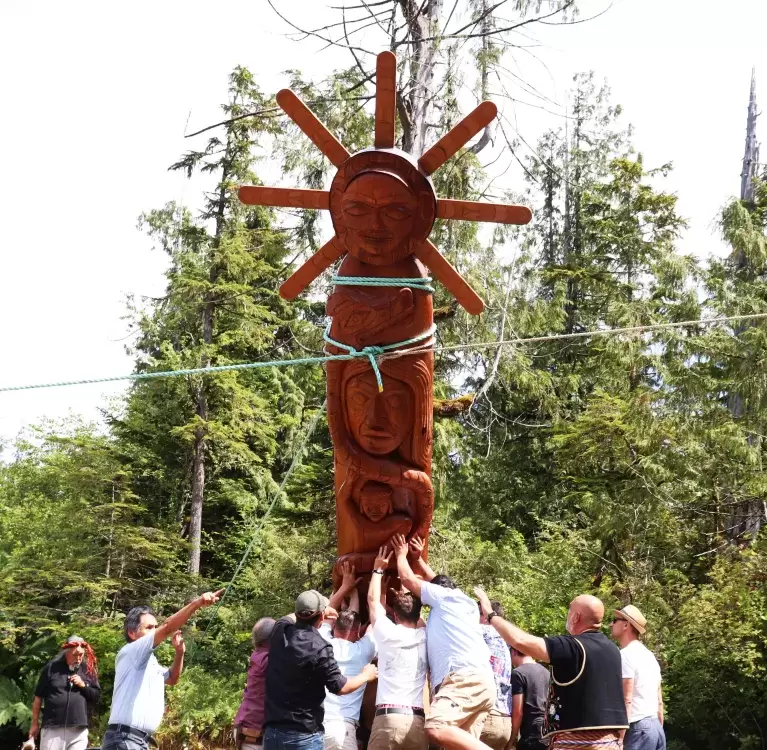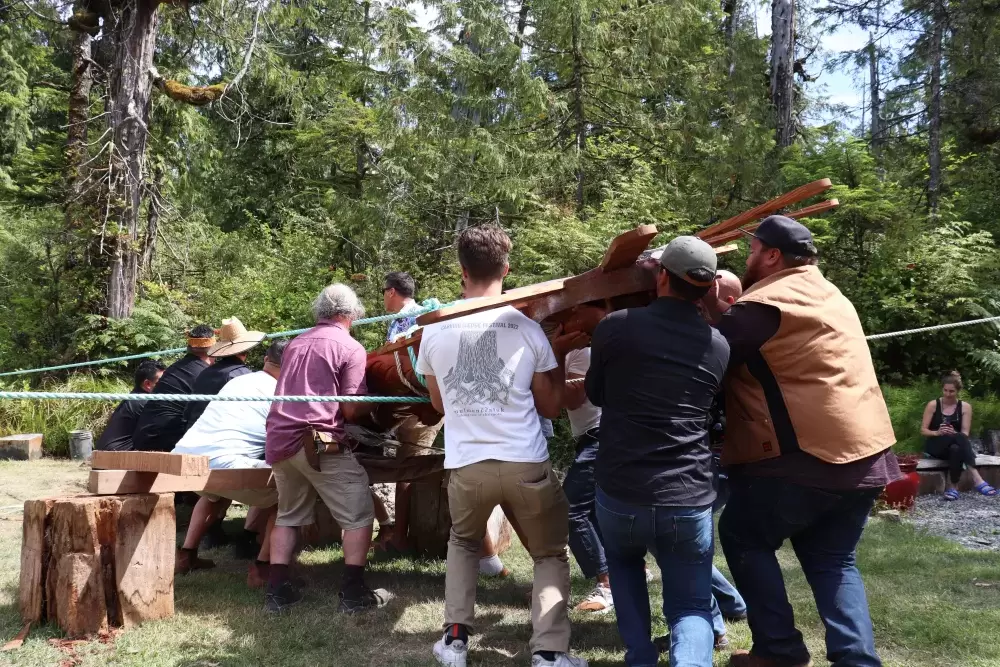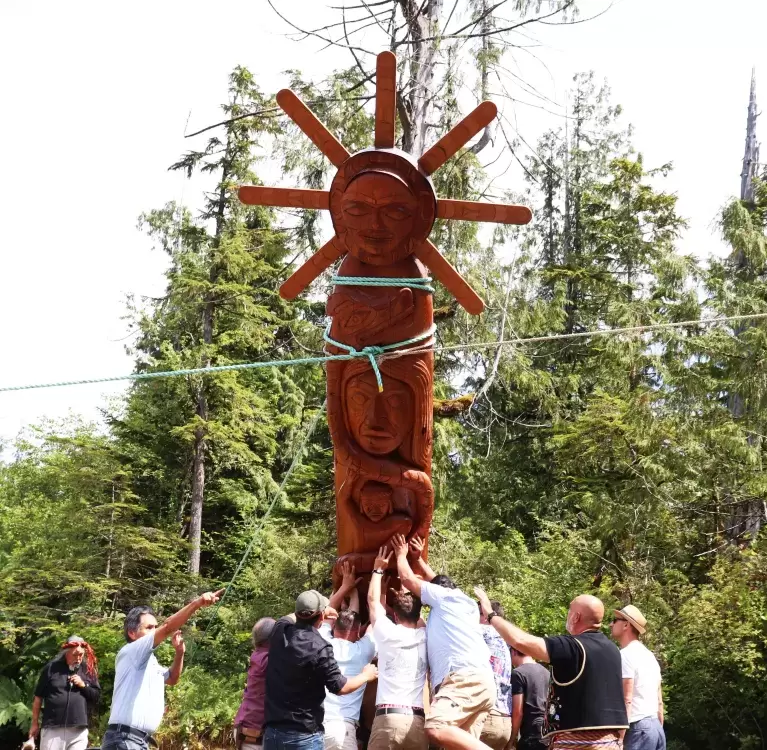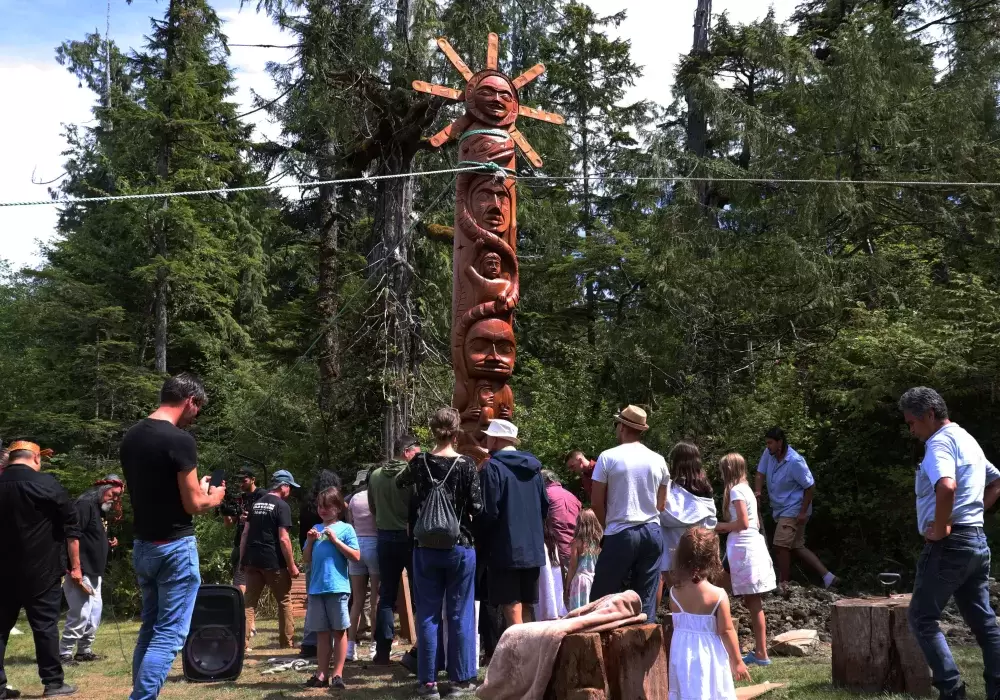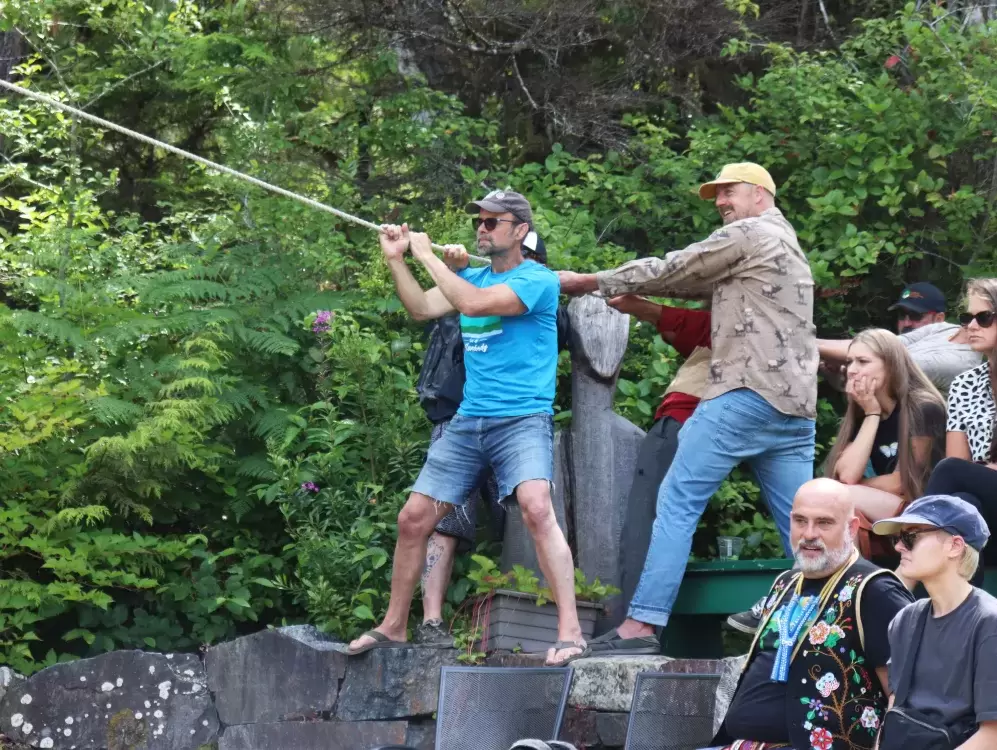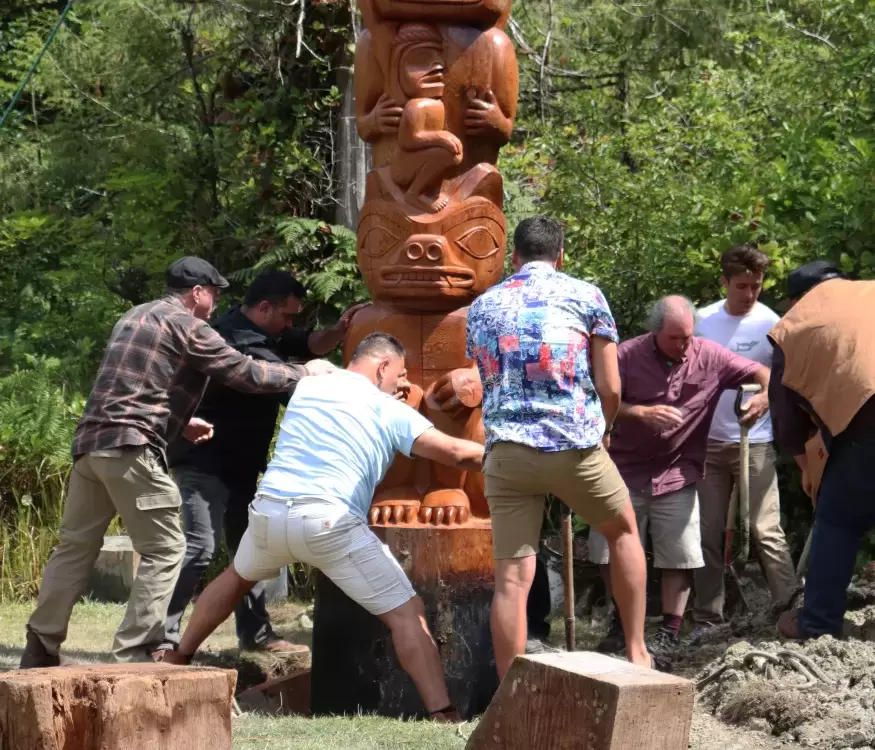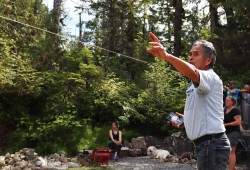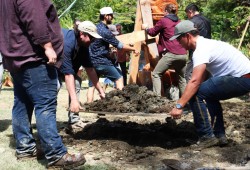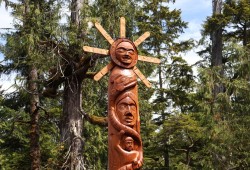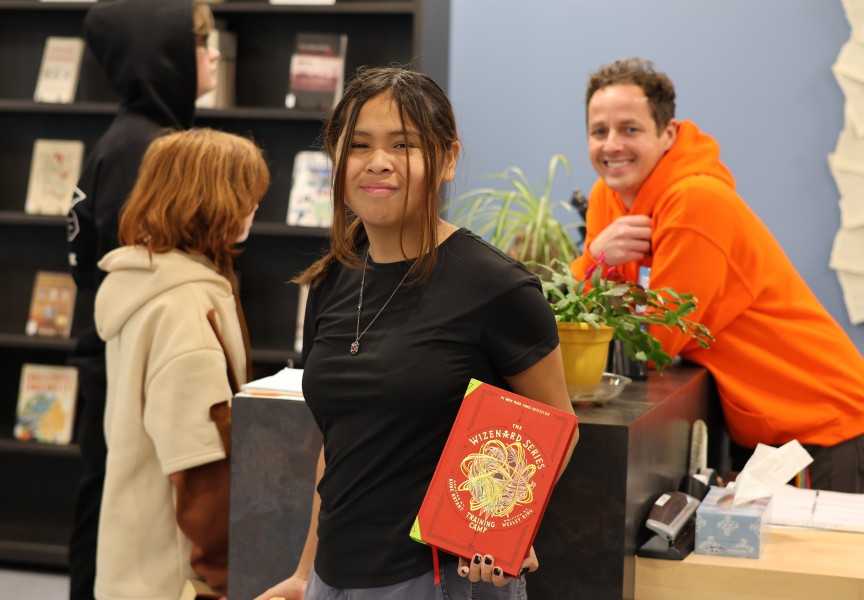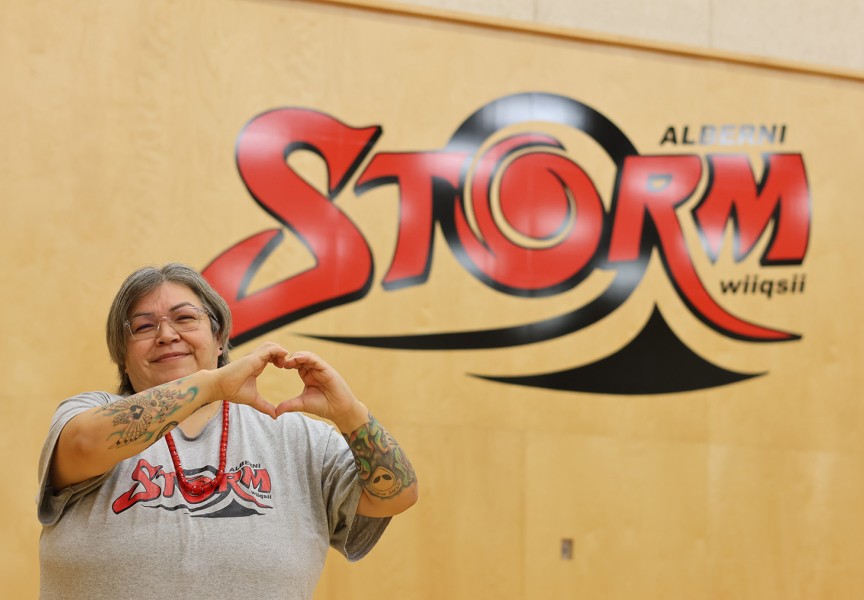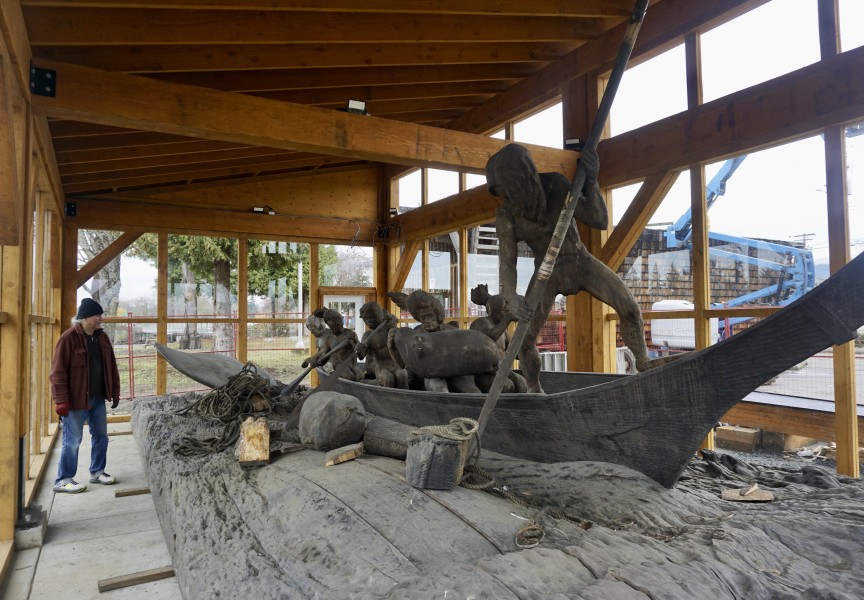On Tuesday, Aug. 1, Naa’was totem pole was raised at Naa’waya’sum garden in Tofino, depicting “responsibilities to future generations”.
“This here is like a legal document of our peoples,” said Joe Martin (Tutakwisnapšiƛ), Tla-o-qui-aht master carver.
The Naa’was totem pole was carved by Joe in collaboration with Gordon Dick, Robin Rorick, Patrick Amos, and Robinson Cook.
“When Europeans first arrived here, certainly, we were illiterate to the things that they wrote on papers,” said Martin. “But so are they when it's in our totem poles; they also had no idea what these things are about.”
“It’s depicting our responsibilities to our future generations,” he continued.
Martin explained that the crests at the top and bottom are the most important parts of the totem pole.
“The top crest can be the crest of the sun, which is the top one up here, or the crest of the moon, which is going to rise later, full, tonight,” he said, referring to the full sturgeon moon that was brightly welcomed later that night.
“The other ones you'll find on top of totem pole[s] are the Thunderbirds… the ones with the wings open, that's depicting our male ancestry,” said Martin. “The ones with the wings closed, it depicts our female ancestry.”
“Always on the chest of the male Thunderbird is depicted the crest of the sun, and on the female Thunderbird, it's the crest of the moon,” he added. “They’re up there, because it's about the first teaching and the first law and that's about respect.”
Martin explained that the crest of the sun is a teaching that begins as soon as a baby is conceived and in the belly of the mother.
“The elders would come there, and they would sing a lullaby when mom was carrying you; and it’s a lullaby and a teaching that went on throughout life,” he said. “Once you were born and every time you're being fed, they would sing this lullaby for you, and when you began to speak that is when they began to speak to you about being respectful.”
Martin then explained that the second most important teaching, which speaks of fear, occurred when children reached a time when they lost their baby teeth and their adult teeth set in; they would be initiated into the wolf clan. He explained that the initiation happened after Dec. 21, between the new moon and full moon.
“The elders said if you are afraid and wanting to learn something and say you only learned so much,” said Joe. “They'd always say if you're not afraid… you can learn anything.”
The bear standing at the bottom of the pole represents a dance performed when young people reached the age of puberty.
“That bear dance, it was done during that time to make the boundaries of our young girls, our ladies,” said Joe. “That boundary, it was a real boundary that was expressed during that song and that dance.”
Joe is the father to Gisele Martin, who spoke about how bears communicate boundaries by nodding their head back and forth, and clicking with their teeth.
“There's a lot of stolen land on this continent and there are treaties that have been made with the French and the British and the Americans,” said Gisele. “But even before all that there were treaties among nations, and even before that…there were treaties that were interspecies; between us and bears.”
“Agreements about how to live here [and] to be respectful,” added Gisele.
Eli Enns, a Tla-o-qui-aht member and CEO of Iisaak Olam Foundation, read a message from Moses Martin, who formerly served as the elected chief of Tla-o-qui-aht for years. He is one of the biggest teachers to Tla-o-qui-aht, said Enns.
“Totem poles tell our story, something that no one can take away,” read the message.
Joe said that there used to be at least four totem poles in front of every house representing the grandparents of the mother and father’s side, which is how teachings from village to village were passed along.
“That's why there used to be so many totem poles in the front of our villages long ago,” said Joe.
In July of 2022, the Hinaaqsuuqʷa totem pole was raised in the village of Opitsaht on Meares Island, where in 1792, 200 totem poles along the village were bombed by Captain Robert Gray.
Just over one hundred years later, in 1900, the Christie Roman Catholic residential school opened on Meares Island. The institution relocated to Tofino in 1971, and officially closed in 1983, reads the National Centre for Truth and Reconciliation website.
According to the National Centre for Truth and Reconciliation, more than 150,000 attended Canada’s residential schools, a system which removed First Nation children from their families to attend the institutions away from home, where they were subject to physical and sexual abuse and not allowed to speak their language or practice their culture.
Many children who attended residential schools did not make it back home.
For Enns, who is also the founder of Naa’waya’sum gardens, it is important that the site gets more totem poles.
“For me, this is history,” said Enns. “[We’re] re-establishing our responsibilities to the land.”
He hopes that for the next generation, the raising of the Naa’was pole at the Naa’waya’sum gardens provides a sense of belonging to their own land.
“To know who we are, to be bold and courageous, and [act in] what's in the best interests of the future generations,” said Enns. “To instill that sense of intergenerational accountability.”
Gisele shared that Naa’was translates to ‘listening to the land,’ and that Naa’waya’sum, the name of the gardens where the totem pole resides, translates to ‘wisdom bench’.
“It takes discipline to take care of the land, and take care of our culture and our language and each other,” said Gisele. “It's really beautiful to see what everybody brought together here today.”

